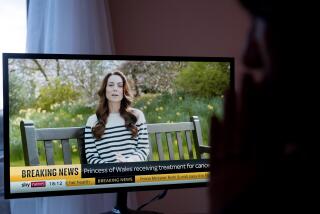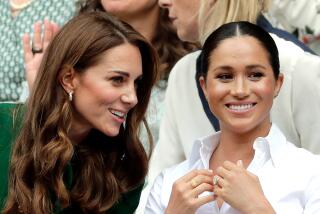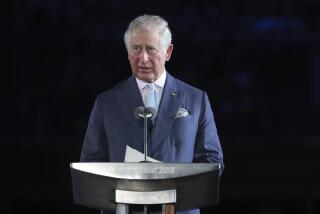Five centuries and one column later, King Richard III controversy refuses to die
Although King Richard III has been dead 500 years, the question of whether he murdered the two little princes in the Tower still arouses passions in the breasts of English-speaking people.
Recently I noted that the King Richard Society would celebrate the 500th anniversary of Richardās death on Bosworth Field, and added my own presumption of his guilt.
Those who consider Richard innocent can be acrimonious.
āYour column this morning,ā writes Pat McKenna of Manhattan Beach, āis contemptible. It is another one of your blatant attempts to make several easy columns out of one. . . .ā
Actually, these follow-up columns are the hardest. Since I more often quote my critics than those who agree with me, I must be careful to quote them accurately, and to make sure that the quotations, however fragmentary, reflect the whole letter and its tone. All quotations are out of context; the trick is to quote in a way that does not betray the context. As I say, it isnāt easy.
McKennaās point, beyond the judgment of my column as contemptible, is that āit was known in the England of his day that Richard III did not kill the little princes, his nephews. You have only to consult a historical source to confirm this fact. . . .ā
The fact is that no historical source confirms any such thing.
McKenna argues also that Shakespeare āwas a flack for the house of Tudor and wrote specifically to please good Queen Bess,ā and concludes, āThe lack of accuracy which you display is almost enough to make one doubt the credibility of an entire newspaper.ā
I do hope that any inaccuracies occurring in this space will not cast doubt on the accuracy of the entire newspaper. They are my own.
Even my friends are divided on the question of Richard.
My friend and former colleague Cecil Smith, now of Carpinteria, writes briefly: āLoved your Richard III column though disagree with your conclusion; R3 was a much maligned fella and Tey was right.ā
āTeyā is Josephine Tey, the British detective fiction writer whose novel, āThe Daughter of Time,ā is canon for the defenders of Richard.
But my friend Robert Hastings, the attorney, and the most important collector of Churchilliana in America, writes: āIf you and Sir Winston say that Richard III done done it, the old boy must have done it.ā
That may seem less than a wholehearted endorsement, but at least it isnāt malicious.
The most gratifying response comes from Frieda M. McKenzie, president and Great Boar of the Richard III Society, Southern California Chapter. McKenzie was so pleased to see the society noticed that she didnāt take umbrage at my own heresy.
āOn behalf of Ricardians around the world,ā she writes, āmay I extend our thanks for your delightful article on the 500th anniversary of the death of our dearly beloved and much maligned King!ā
As I say, I donāt usually publish friendly letters, but I think it is only fair to show that the Ricardians in general are amiable people.
DeVallon Scott of Camarillo, who evidently is a student of the king, quotes the British historian and Shakespearean scholar, A. L. Rowse:
āNot only was the overwhelming majority of the nation convinced that Richard had used his power as Protector to usurp the crown and that the Princes had disappeared in the Tower,ā but also āif only he had been able to produce the princes alive from the Tower he would have been able to answer his enemies. He never could: they were dead precisely two years before Bosworth. . . .ā
As for the charge that Shakespeareās play was based on Sir Thomas Moreās account, which was a piece of propaganda for Richardās successor, the Tudor King Henry VII, Rowse says: āThomas More was a truth-telling man of great political intelligence and close observation, who had still closer sources of information as to Richardās coup dāetat. . . .ā
David Carl Argall of La Puente agrees that Richard had the motive and the opportunity, and probably did it; but he takes issue with my view of Richardās courtship of the murdered princesā older sister, through her mother, as an act of āmonstrous effrontery.ā
Argall argues that Richardās offer was āa surrenderā in settlement of a family feud, and that Elizabethās mother would have ājumped at the chanceā to feather her own nest, as well as that of her daughter.
Readers have recommended āThe Sunne in Splendour,ā by Sharon Kay Penman, as vindicating Richard, and āRichard III,ā by Paul Murray Kendall, which, according to H. Dixon Trueblood, suggests that āif Richard is not entitled to an exoneration, the case for guilt is at least a draw between Richardā and two contemporaries.
I must point out a more recent nonfiction work, āRichard III and His Early Historians,ā by Alison Hanham, who argues that Richard was indeed accused of usurpation and murder in his time, though the fate of the princes remained uncertain. From this book the London Times Literary Supplement concluded: āRichard is back where he belongs: in the gallery of quite determined villains.ā
Against this scholarship, I am reminded by Helen D. Cure that on Nov. 9, 1984, the Los Angeles Times printed the following story:
āFive hundred years after his death, a British TV ājuryā found King Richard III not guilty of murdering his nephews, the Little Princes, in the Tower of London. The king, the jury decided, was the victim of propagandists of the subsequent Tudor dynasty, particularly one William Shakespeare.ā
To quote an unreliable source, āWhat fools these mortals be!ā
More to Read
Sign up for Essential California
The most important California stories and recommendations in your inbox every morning.
You may occasionally receive promotional content from the Los Angeles Times.










